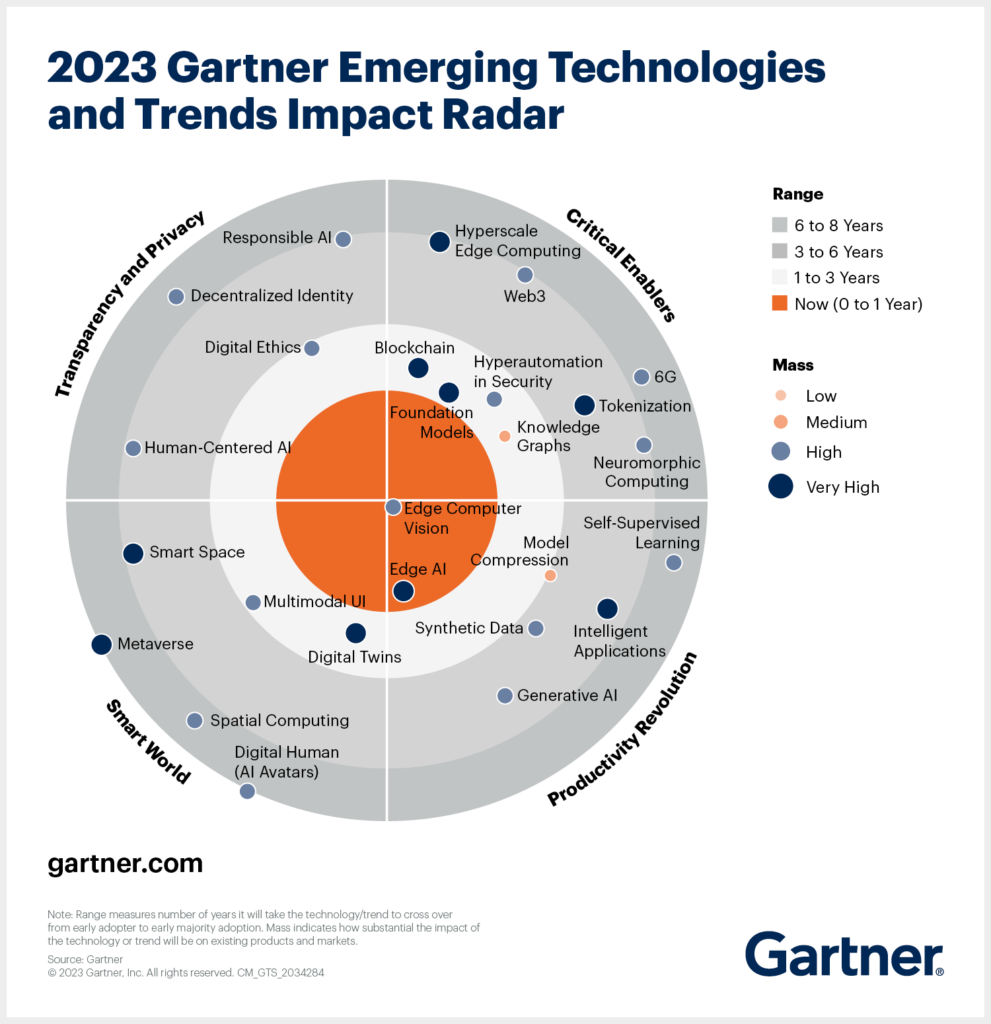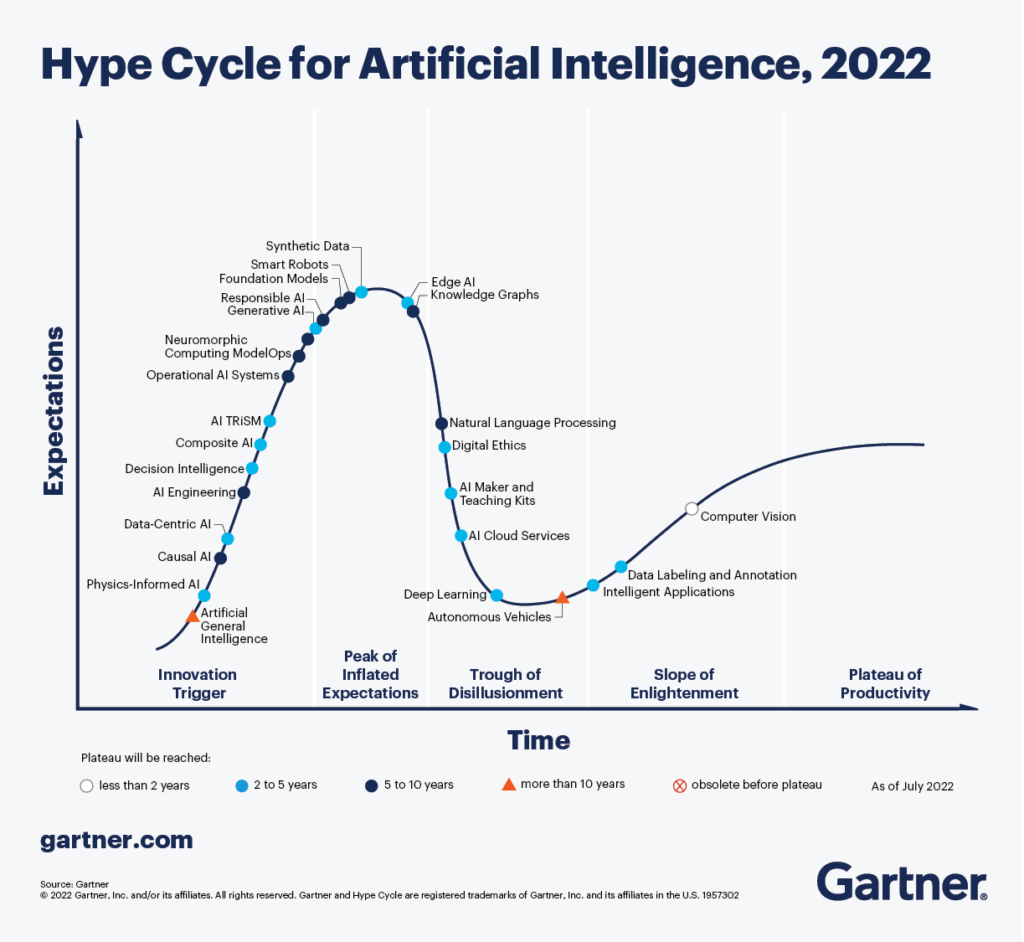Video analytics for Smart Cities
The usefulness of video analytics solutions for Smart Cities was thrust into the spotlight during the peak of the pandemic. Many academic studies – such as research from Bengaluru’s Ramaiah University, Face mask recogniser using image processing and computer vision approach – were conducted, advocating the potential benefits of programmatic face mask detection with computer vision and enforcing social distancing with computer vision. Now, authorities are turning their attention to video analytics for people counting in Smart Cities.
As the severity of the pandemic eases, the usefulness of computer vision for smart cities is being evaluated more broadly – beyond the initial public health response. In fact, the growing prominence of computer vision in our day-to-day lives is evidenced by its central position in the 2023 Gartner Emerging Technologies and Trends Impact Radar:

The increasing applicability of computer vision software to pragmatic use cases – today – is also underscored in another recent Gartner report; the 2022 Hype Cycle for Artificial Intelligence.

Of all the prominent AI technologies on Gartner’s radar, it’s computer vision that’s fast approaching the ‘Plateau of Productivity’, with the global research giant citing the increased adoption of synthetic data as a key driver.
Video analytics for people counting in Smart Cities
Beyond enabling COVID-safe practices, video analytics has the potential to optimize essential services, create safer communities and facilitate data-driven planning. Potential use cases are extensive. In hackernoon.com’s piece – 5 Intriguing Applications of Computer Vision in Smart Cities – ReHack Editor, Zac Amos, cites the ability to help first responders. Analytics Insight highlights automated harvesting and road condition monitoring in its exploration of the subject, 10 Ways Computer Vision is Used in Smart Cities.
But, the sheer number of potential use cases can make it overwhelming for governments, infrastructure and construction firms – and many other entities involved in public works – when considering the paybacks of computer vision software for Smart Cities. Where do you start?
So, to keep the theme of video analytics for people counting going (following on from last week’s blog on the benefits of retail video analytics for people counting), that’s where we’ll focus today’s discussion too: The advantages of applying computer vision technology to people counting in the context of Smart Cities.
10 benefits of video analytics for people counting in Smart Cities
Utilizing computer-vision-based people counting methods can produce a surprising number of insightful outcomes for Smart Cities.
Benefits of programmatically detecting, counting and tracking people with video analytics for smart cities include:
1. Aiding urban planning: Measure footfall volume, density and flow patterns throughout public spaces and facilities. Generate insights regarding service and infrastructure utilization over time. Understanding people counts and foot traffic trends supports effective planning decisions in a multiplicity of ways: From where to build public amenities and construct new roadways; to establishing new green spaces and enabling effective commercial vs residential zoning practices.
2. Optimizing public transport: Monitoring footfall patterns in and around transport hubs and stops / stations – from trains, trams, buses and ferries – helps match services with demand. Shift timetabling and future investment plans to optimally align the type, frequency and location of public transport services with utilization statistics and pedestrian data. And, combine video analytics for people counting with vehicle counting and traffic analysis to generate an additional layer of insights. Facilitate prudent future investments, and assess the impact of current public transport decisions, by analyzing vehicle patterns and congestion.
3. Easing traffic congestion by facilitating more non-vehicular travel: With CO2 emissions, increased urbanization and housing density front-of-mind, local municipalities and governments at all levels are seeking ways to encourage more man-powered commuting. Using video analytics solutions for people counting – including the ability to detect, track and segment pedestrian traffic by type (such as person, cyclist, scooter, pram, shopping cart and wheelchair) – authorities can make effective data-based decisions. Allocate and justify funding for more connected bike tracks, walking paths and vehicle-free streetscapes based on current utilization data and emerging pedestrian trends.
4. Boosting tourism: Combine footfall data, tourist statistics and even Point-of-Sale information to unearth patterns that help generate more tourism dollars and optimize tourism campaigns. Upgrade facilities, conduct more effective location-based advertising, build more attractions and issue more permits, liquor licenses or economic development grants to businesses based on existing demand and emerging foot traffic trends.
5. Supporting small business: Provide footfall data to local businesses to attract and retain vendors, retailers, publicans and hoteliers. Demonstrate the volume of exposure to potential customers. Provide the analytical insights businesses need to understand peak hours and plan accordingly. And, enable them to measure foot traffic to sale conversion rates.
6. Managing public events and crowds: Live counts and density analysis can help authorities manage crowds in real-time. Detect overcrowding and potential bottlenecks as they occur. Dispatch or re-deploy event staff – and even emergency service personnel – to high-traffic locations as required. Analyzing foot traffic numbers and pedestrian flows after-the-fact can also help to plan safer, better-serviced events in the future.
7. Improving public health and safety: Use real-time and aggregated footfall metrics to allocate police patrols in-the-moment, and better-locate future facilities, to improve emergency service response times. Monitor public spaces and detect suspicious pedestrian or atypical crowd behavior early. Prevent and mitigate potentially dangerous situations, such as crowd crushes, anti-social or unlawful activity.
8. Reducing energy consumption: With climate change taking a central position in public policy, streamlining energy usage is both practically and politically important. Undertaking people counting and pedestrian analysis around public buildings, spaces and office blocks can help governments and building authorities efficiently regulate heating, cooling and lighting based on occupancy data.
9. Improving inclusivity and accessibility: When spending public funds on public facilities and services, authorities are mandated to provide equitable access. Video analytics solutions for people counting and pedestrian analysis can analyze foot traffic flow – including segmenting data based on attributes, such as wheelchair usage. These video-based insights can be used to pinpoint where and what accessibility improvements might be required, including the installation of ramps or elevators at parklands or transport hubs.
10. Optimizing waste management: Video analytics solutions for people counting can help improve waste management in a number of ways. Firstly, deploying people counting solutions at recycling and waste collection centers can help catch and stop illegal dumping. Authorities can also monitor waste disposal patterns and volume, optimizing waste collection routes, frequency and pick-up schedules to align with demand.
Where to next?
If you found this blog to be of value, why stop there? Access our complimentary whitepaper on the topic here: People Counting and Pedestrian Analysis with Computer Vision.




